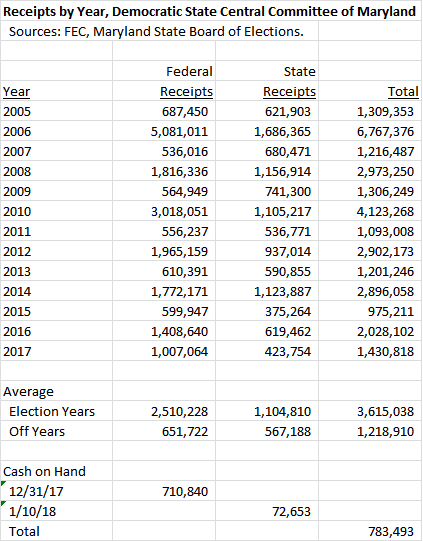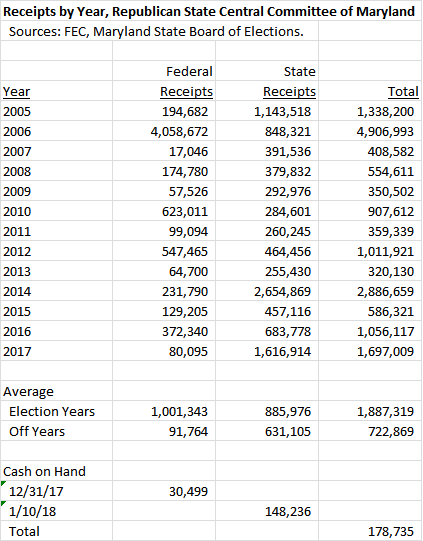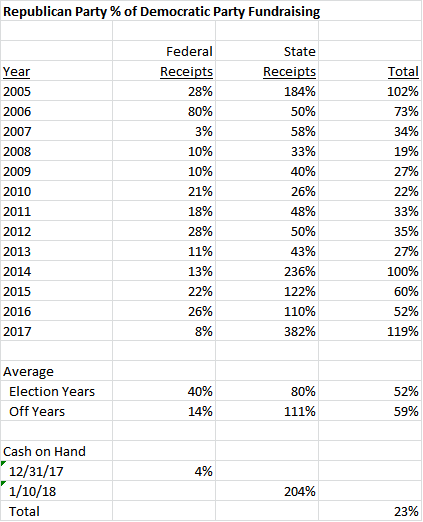The Maryland Democratic Party has issued a press release supporting gubernatorial candidate Valerie Ervin’s effort to be included on the ballot. We reprint the release below.
Category Archives: Maryland Democratic Party
Maryland GOP Catching Up to Democrats in Fundraising
By Adam Pagnucco.
Maryland is a majority Democratic state. So one would expect that in financial competition between the two state parties, the Democrats would blow the Republicans away. That may have been the case a few years ago, but not anymore.
In Maryland, the two state parties have two campaign accounts each: a federal account used for promoting federal candidates and a state account used for promoting state and county candidates. Contributions to the federal account are regulated by federal election law while contributions to the state account are regulated by state election law. Both federal and state money can be used for purposes like paying staff, voter registration and voter turnout so there is a bit of flexibility in use. There are a few local party accounts but they are dwarfed by the state parties.
Below is the distribution of federal and state fundraising for the Democratic State Central Committee of Maryland. A few things stand out. First, because there are many Democratic federal elected officials, federal fundraising often exceeds state fundraising. Second, election year receipts are far greater than off-year receipts. Third, the presence of a Democratic Governor and/or a marquee federal race (like the 2006 U.S. Senate contest between Ben Cardin and Michael Steele) is good for fundraising. In 2017, the first year for current Democratic Chair Kathleen Matthews, the party exceeded its off-year pace in federal money but slightly lagged its typical state fundraising. Still, despite not having the Governor’s seat, the party did pretty well and finished 2017 with almost $800,000 in the bank.
Below is the same information for the Republican State Central Committee of Maryland. The GOP’s federal fundraising is often puny due to its lack of federal elected officials. (The 2006 race involving Michael Steele was a big exception.) But in state money, the Republicans do better than the Democrats when they have an incumbent Governor. They have led the Democrats in state fundraising four years in a row and exceeded them in total money raised in 2005, 2014 and 2017. Their total cash on hand at the end of 2017 was about a quarter of the Democrats.
The chart below shows GOP fundraising as a percentage of the Democrats. Again, notice how the last four years stand out in how the Republicans have exceeded the Democrats in state-level fundraising. The Democrats’ advantage in federal fundraising can be used for staff and voter activity but it cannot be used to directly promote the party’s gubernatorial nominee in the coming election.
Governor Larry Hogan will have an enormous financial advantage against whoever wins the Democratic nomination and the two parties could be at rough parity. If Hogan wins, it’s reasonable to assume that the GOP will continue to raise as much or more in state-level money as the Democrats during his second term. That would be a nice boost for the next generation of Republicans looking to succeed him.
Democratic Voter Registration Has Fallen Since Trump’s Election
By Adam Pagnucco.
Despite a wave of anti-Trump activism from the left, Democratic voter registration in Maryland has actually fallen since the President’s election in November 2016. Is that a problem?
To answer that question, let’s start with this fact: since November 2016, voter registration among Maryland Democrats has dropped from 2,179,948 to 2,134,776 in February 2018. That’s a decline of 2%. Over the same period, voter registration has dropped by 2% among Republicans, risen by 2% among independents and other party members and declined 1% overall.
The state’s voter registration numbers go back to 2000. Over that period, while registration has risen generally, it is tied to election cycles. After each general election, registration drops, but then begins rising prior to the next general election. The chart below shows that pattern clearly for all categories of voters.
Each election cycle has seen an inflection point, a month in which registration has stopped falling and started rising steadily through the next general election. Over the last four presidential cycles, the inflection point has occurred on average fifteen months before the general election. Over the last four gubernatorial cycles, the inflection point has occurred on average eight months before the general election. Here are the registration gains by category from average inflection point to general election in each of those cycles.
A few things stand out. First, registration gains are far higher in presidential cycles than in gubernatorial cycles. Second, the long-term trend in both kinds of cycles is decline in the rate of gain. Third, a sharp fall in registration gains among non-Democrats and non-Republicans in the 2016 cycle may reflect significant discontent with the two major party nominees. And fourth and most relevant, flat-lining Democratic registration may have been a portent of Anthony Brown’s loss in 2014.
What is happening now? Our latest data point is February 2018, fifteen months after the 2016 general election. We compared voter registration gains from the last presidential election to fifteen months later over the last five cycles to put the last fifteen months in perspective. Overall, it’s normal for registration to fall over that period of time. On average, registration is down 2% for Democrats and Republicans, up 2% for others and down 1% overall for those 15-month periods.
From November 2016 through February 2018, voter registration fell among Democrats and Republicans by 2%, rose among independents and other party members by 2%, and fell for all voters by 1%. These are the exact same rates as the average for the last five cycles.
This goes against the prevailing narrative that President Trump’s conduct in office is producing a revival of the Democratic Party. It’s true that Democrats have put together a string of special election wins around the country and many analysts are predicting that they might take over one or both chambers in Congress. It’s also true that changes in registration don’t always correspond to changes in actual voting. But in Maryland, at least on the measure of voter registration, Democrats have not appeared to capitalize on anti-Trumpism to bolster their ranks. Voter registration trends are behaving normally, not abnormally as one might expect in the age of resistance to Trump.
This is good news for Governor Larry Hogan. As for Maryland Democrats, perhaps questions should be asked.
Give Kathleen Matthews a Chance
By Adam Pagnucco.
Former WJLA anchor and Congressional District 8 candidate Kathleen Matthews has been picked as the Interim Chair of the Maryland Democratic Party. And as someone who was asked to run by the party’s senior elected leadership – namely, U.S. Senators Ben Cardin and Chris Van Hollen and Representative Steny Hoyer – she seems likely to be named the four-year Chair as well. That has set off a round of protest among some liberals in the party, with echoes of last year’s primary battles.
Two comments are noteworthy. First, former Montgomery County Council Member Valerie Ervin said that Matthews’s appointment “missed an opportunity to open up the space for a new and different kind of leadership.” That was essentially the rationale for the U.S. Senate campaign of Ervin’s good friend, Donna Edwards. Second, Maryland Matters columnist Josh Kurtz blasted Matthews as “an especially thin reed” and “the wrong candidate at the wrong time” who could not connect with either progressives or Hogan voters.
In evaluating these criticisms, it’s worth contemplating just how much trouble Maryland Democrats are in right now.
- Governor Larry Hogan has rung up a string of job approval ratings of 60-70% or more, including majority approval in some polls among Democrats. He is on pace to raise tens of millions of dollars for his reelection campaign. He is absolutely dominant in social media. And he is only seven GOP votes away from having his vetoes sustained in the House of Delegates. If Hogan returns to Annapolis with enough Republicans to support his vetoes, Maryland will have a real two-party state government.
- Outside Annapolis, the Democrats’ hold on county offices has collapsed since the 2002 elections. The Democrats are almost extinct in most of Western Maryland, the Eastern Shore and Harford County. The Republicans firmly control Anne Arundel and are competitive in Baltimore County. The Howard County Executive is a Republican. The Democrats dominate in Baltimore City, Montgomery, Prince George’s and Charles. That’s about it.
- The Maryland Democratic Party apparatus has degraded. It could not help Anthony Brown get elected Governor in 2014. Some local parties complain about lack of support. The party’s federal receipts in the 2016 cycle ($2.8 million) were the lowest in any two-year cycle since 2004. The party’s state-level account raised just $6,650 last year, about one-eighth of what the Republicans raised. There is little in the way of an aggressive communications program on the Governor’s record in office. Individual Democratic state legislators complain about issues like Hogan’s Facebook page and his executive order on Labor Day, neither of which will result in electoral harm to the Governor. The party lacks a battle plan for taking on the Governor other than associating him with Donald Trump. It needs a plan, and fast.
Enter Kathleen Matthews. As a candidate in CD8, she did a lot of things right: raising money, getting the Washington Post endorsement and running a competent, professional campaign. She lost because she did not have David Trone’s money, did not spend ten years building a grassroots base like Jamie Raskin and did not sufficiently address local issues. Since the campaign, she has played a key role in helping women run for office through Emerge Maryland, unquestionably a hugely important exercise in the Era of Trump. Let’s recognize that unlike many other losing candidates who disappear after the election, Matthews has remained engaged.
Some of the criticisms of Matthews relate to her positions and conduct as a candidate. But Matthews is not going to be a candidate for government office if she is Chair of the party. Other people will run for Governor, state legislature and county office and they will face the judgment of the voters. As Chair, Matthews’s job will be to raise money and rebuild the party’s communication and field capabilities. She is as plausible a choice as anyone to accomplish those tasks.
Consider this. One of the most effective techniques of political communication is story-telling. Imagine a video interview with a Baltimore City teacher or family affected by Hogan’s cuts to city schools. Or an interview with a provider of developmental disability services who would earn fast food industry wages under Hogan’s budget. Or a profile of a family who would lose Affordable Care Act health insurance coverage while Hogan stands idly by. Or a story about a positive initiative from a local Democratic elected official fixing a problem for constituents. Imagine a mass email and social media program spreading these pieces to hundreds of thousands of voters. Who in the entire state party is better suited to this kind of video story-telling than Kathleen Matthews?
Of course, we’re the Democrats. We often fight harder against each other than against Republicans. We could criticize Matthews as not liberal enough, not working class enough or not local enough. We could keep fighting the Bernie vs Hillary battles, the Donna vs Chris battles or the Tom vs Keith battles. We could keep arguing over who’s perfect and who’s not. Sure, let’s do that. Hogan would love it. That’s exactly what he wants us to do.
Or we could unite all of our various factions, our passions and our abilities and take our case directly to the streets of Maryland. We could spread far and wide what we know to be true, which is that Maryland can do a lot better than Larry Hogan and Donald Trump. And we could take advantage of the fundraising and media skillsets that Kathleen Matthews has to help us do it.
Democrats of Maryland, the choice is yours.
MCDCC Chair Says One Thing, MDDEMS Another
The Montgomery County Democratic Central Committee (MCDCC) held training for Democratic precinct officials this past Saturday and several sources report was controversy over access by precinct officials to MDVAN–the Maryland Democratic Party’s voter database.
MDVAN allows users precinct officials to select out different groups (e.g. new voters, Spanish-speaking voters, inconsistent voters) of voters for get-out-the-vote (GOTV) purposes. It also allows the creation of walk lists so that canvassers can conduct their work efficiently. In the past, precinct officials have been given access to the database but only for their one precinct.
MCDCC Chair Kevin Walling Says One Thing
When asked about goals for the training by MCDCC Precinct Coordinator Melissa Pinnick, many responded that they would like to learn how to do more with MDVAN. Eventually, MCDCC Chair Kevin Walling explained that precinct officials would no longer be given access to MDVAN and made clear that this was state party’s decision.
Instead of MDVAN, precinct officials were told that they would be given a PDF with lists of voters from their precincts. Precinct officials were not happy–many have worked their precinct for the Dems for a very long time–and asked who they should contact to do something about it.
But MDDEMS Say Another
Maryland Democratic Party Compliance Director Meredith Bowman explained to me that access to MDVAN is completely at the discretion of county party chairs. I also did not get the impression that the state party was aware of the issue in Montgomery County or that they had demanded the change.
In response to my query about why he decided to deny precinct officials access to MDVAN and other questions, Kevin Walling communicated via email that he had to consult the MCDCC Executive Committee. While there may well be another side to this story, I don’t know his or MCDCC’s viewpoint.
Rep. Chris Van Hollen
Rep. Van Hollen spoke to the precinct officials on Saturday and gave a good rousing speech that communicated the value he and other elected officials place in the precinct organization for getting out the vote for the party year in and year out.
Apparently, the MDVAN issue would not go away and he was asked publicly about it by a precinct official. Once the issue was explained to him, Rep. Van Hollen said immediately that this is exactly the sort of thing that drives him crazy and that he would see what he could do about it.
MCDCC Reverses its Decision
By Monday, MCDCC was saying that precinct officials who want access to MDVAN can have it. MCDCC confirmed this at its official meeting on Tuesday.







